S
Maybe I could put the above in context another way: If you are on a committee to decide what distortion measurements matter, and you and or your system are not good enough to hear is different about those files, what are you doing on the committee? You may know how to measure amplifiers, but you sure don't know what is audible to some fraction of the population. And you are likely to misinterpret published research in a way which is biased toward your own ability to listen as some sort of reasonable point of reference to go by (anchoring effect, a cognitive error), whatever it may happen to be.BTW, it turns out I saved those files. After all these years I just now listened to two of them on my laptop with $20 amazon headphones. They still sound different to me, although not exactly like what I would normally think of as HD/THD. Just some slight differences between some of the cymbals. Anyone interested in giving them a try?
I have been thinking about an amplifier figure of merit aka AFOM. Unfortunately, assessing amplifiers objectively appears to have gravitated just one parameter: THD. I would argue this is as bad as the subjectivists who have thrown measurements out of the window. We now have a situation where a very suboptimal amplifier in most of the categories detailed below would be assessed as very good because it measured well on just THD.
I would be interested to get your views on what should be included and what not be included. Ideally, one would want to limit the rating categories to at most 10 items otherwise it would quickly get unwieldy. For example, PRaT would not be a thing in the proposed AFOM and neither would 'airy highs due to using zero feedback'.
So, I'll give it a first cut below, and then depending on how the discussion goes, the ratings can be changed or adjusted so that hopefully we end up with a system that objectively assesses amplifier performance holistically rather than just the dreaded 100 ppb distortion simulation result or THD measurements alone that ultimately mean nothing. I look forward to your comments.
The proposed rating system has been renamed 'Audio Amplifier Assessment Program' to reflect the feedback that a single rating number is not adequate to describe an amplifier.
AAAP Objective: -
A set of assessment criteria that objectively ranks amplifier performance so that in an ideal case, a higher-ranking amplifier would score well on measurement and on DBT. The target demographic is home audio, driving loudspeakers in the 83-105 dB sensitivity range with an impedance rating of 2 – 8 Ohms. The document is also envisaged as a guide for engineers in the amplifier design stage so they are focused on spending their effort on a holistic set of metrics, rather than just one.
The initial document is attached below. Ignore the scoring numbers for now, and let us focus on just what we intend to measure. I would caution against trying to put tests in or change tests, where no existing test yet exists. If it is decided a completely new kind of test is required, someone is going to have to go away and write that so it can run on a sound card or audio test set like the QA401/2/3. Any new tests like this should be backed up by scholarly research IMV if it is going to be taken seriously - eg GEDLEE etc.
For the time being, it's probably better that we get a first release out and start assessing our amps with it. Any new tests we concluded should be added, or existing ones changed, should be the subject of a document update.
The document will be further updated later this week to add sample graphs and reports.
🙂
Fundamentally, you are ignoring how the amplifier sounds and how closely it presents a facsimile of the actual performance.
Instead, you are focusing on other ancillary factors which may have NOTHING to do with its ability to recreate the live event.
Sorry, but your list belongs in ASR.
To give you some constructive criticism.... you need to define what is "good" sound... and for that you will need to create a "good" sounding system. Including a reference source, amplification and acoustic transducers.
Record a live performane with cardiodis and one of them mikes in a head setup.
For source, use some clean impulses, some sinewaves, some time variant signals an then some musical performances.
Analyze the signal.
Now play it back through a reference system that people agree sounds closely like the actual performance.
The the same kind of mikes and record that.
Measure the difference.
That, IMHO, is the first start.
From a scientific point of view, I think it would also help tremendously to understand our psychoacoustics.
No, read carefully what I wrote.
I call for measuring, analyzing and comparing two sets of recordings.... that is true science.
We combine both objectivity and subjectivity.
And thus, once we truly get a hold of what makes an amplifier sound good, then we can create a set of measurement criteria that will allow us to measure the quality of an amplifier based on objectivity alone.
Until then, we need to take into account psychoacoustics and therefore you can not more the 'quality" of an amplifier solely by a set of measurable and repeatable metrics.
Anything else is religion. Indeed, the fundamental subject of the OP's quest is quixotic, as I pointed out, so I came up with another way of obtaining the metric... which relies on an a priori agreement of the "reference" system.
Again, read what I wrote again.
I call for measuring, analyzing and comparing two sets of recordings.... that is true science.
We combine both objectivity and subjectivity.
And thus, once we truly get a hold of what makes an amplifier sound good, then we can create a set of measurement criteria that will allow us to measure the quality of an amplifier based on objectivity alone.
Until then, we need to take into account psychoacoustics and therefore you can not more the 'quality" of an amplifier solely by a set of measurable and repeatable metrics.
Anything else is religion. Indeed, the fundamental subject of the OP's quest is quixotic, as I pointed out, so I came up with another way of obtaining the metric... which relies on an a priori agreement of the "reference" system.
Again, read what I wrote again.
Last edited:
@Bonsai , I am using a set of FM signals, more here:
https://www.audiosciencereview.com/...istortion-with-fm-modulation-technique.37697/
Some results, original signals + responses:
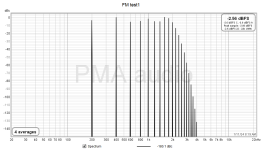
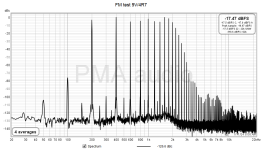

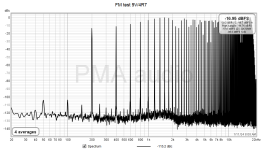
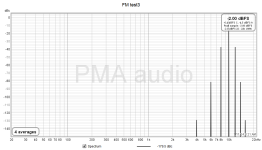
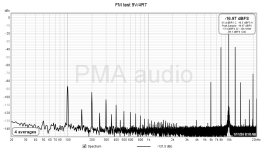
Please also note a different LF hum rise.
https://www.audiosciencereview.com/...istortion-with-fm-modulation-technique.37697/
Some results, original signals + responses:






Please also note a different LF hum rise.
There are many problems in your suggested approach such as:I call for measuring, analyzing and comparing two sets of recordings.... that is true science.
We combine both objectivity and subjectivity.
- Acoustic transducers (and room) have much more impact to perceived sound than amplifier. Differences in recordings made between equally measuring amplifiers will be very small to non-existing and mostly masked by non-linearities in acoustic transducers.
- There will be no consensus on reference system
- How to decide what to measure and analyze in the recordings (basically the same issue as this thread is trying to solve)
Adding a cap to the output of an amp will cause any HF poles above the ULGF to migrate down in frequency and up in mag with concomitant reduction in gain/phase margins in an amplifier that is not sufficiently well isolated from the load using a coupling inductor - some commercial products gave even used low value resistors in the past.
As I mentioned in my notes above, ringing of the output L and load capacitance is a feature of all amplifiers. It’s pretty easy to separate out this type of normal expected ringing and oscillation. I did some notes on it here when it was decided by some that output inductors were passé :-
https://hifisonix.com/power-amplifiers/audio-amplifier-output-coupling-inductors/
As I mentioned in my notes above, ringing of the output L and load capacitance is a feature of all amplifiers. It’s pretty easy to separate out this type of normal expected ringing and oscillation. I did some notes on it here when it was decided by some that output inductors were passé :-
https://hifisonix.com/power-amplifiers/audio-amplifier-output-coupling-inductors/
Bonsai, there are some things in your simulation which make your results overly optimistic.
1: The 8ohm resistor in parallel with the capacitor reduces the Q to a point where it is unlikely to cause trouble. This is why it seems like you can get away with no resistor in parallel with the output inductor.
2: R11 is analogous to 44ohm base stoppers on the driver transistors and makes this amp better behaved than a lot of amps are. Good choice, but it is a best case scenario.
3: The fact you can put an inductor in series with the load without having an RC to ground at the outputs shows that the unity gain point is well below how far this amp could be pushed, and TMC/TPC makes capacitive load sensitivity worse.
It's nice that you have constructed such a well-behaved amplifier but higher perfoming designs which make better use of the available loop gain while still having good frequency response will not respond in the same way to a simple output inductor when the load has some realistic inductance.
1: The 8ohm resistor in parallel with the capacitor reduces the Q to a point where it is unlikely to cause trouble. This is why it seems like you can get away with no resistor in parallel with the output inductor.
2: R11 is analogous to 44ohm base stoppers on the driver transistors and makes this amp better behaved than a lot of amps are. Good choice, but it is a best case scenario.
3: The fact you can put an inductor in series with the load without having an RC to ground at the outputs shows that the unity gain point is well below how far this amp could be pushed, and TMC/TPC makes capacitive load sensitivity worse.
It's nice that you have constructed such a well-behaved amplifier but higher perfoming designs which make better use of the available loop gain while still having good frequency response will not respond in the same way to a simple output inductor when the load has some realistic inductance.
Keantoken, this is not an amp that was ever built.
It’s simply a simulation showing the usefulness (or not if that’s what the designer decides) of using an output inductor. No damping resistor or Zobel were included to emphasise the problems of capacitive loading and LC ringing. Adding a damping resistor as is done in a practical amp does not change the normal LC ringing behaviour but only damps the instability peak (that’s the ‘spike’ you see in some of the plots).
The amp was compensated in the first plot for 85 deg phase margin and good gain margin - the idea was to show that even if the compensation was good, capacitive loading without some form of isolation from the amp output is still an issue in feedback amplifiers. The less the phase and gain margin, the worse the problem becomes.
At the end of the day, the designer has to decide what margins they are willing to accept in their amplifiers and that was the thrust of the conclusion on the last slide.
It’s simply a simulation showing the usefulness (or not if that’s what the designer decides) of using an output inductor. No damping resistor or Zobel were included to emphasise the problems of capacitive loading and LC ringing. Adding a damping resistor as is done in a practical amp does not change the normal LC ringing behaviour but only damps the instability peak (that’s the ‘spike’ you see in some of the plots).
The amp was compensated in the first plot for 85 deg phase margin and good gain margin - the idea was to show that even if the compensation was good, capacitive loading without some form of isolation from the amp output is still an issue in feedback amplifiers. The less the phase and gain margin, the worse the problem becomes.
At the end of the day, the designer has to decide what margins they are willing to accept in their amplifiers and that was the thrust of the conclusion on the last slide.
Last edited:
I read through the link Pavel - thanks for that. How could we use this as a test where we could pull a number from it? For example, I am assuming the FFT could be passed through a python script and all the tones not present in the test tones (ie the expected tones from the FM modulation) extracted and then summed in some way with a negative weighting the higher order harmonics?@Bonsai , I am using a set of FM signals, more here:
https://www.audiosciencereview.com/...istortion-with-fm-modulation-technique.37697/
Some results, original signals + responses:
View attachment 1258562 View attachment 1258563
View attachment 1258564 View attachment 1258565
View attachment 1258566 View attachment 1258567
Please also note a different LF hum rise.
I guess we would still do the 19+20 full power IMD to catch SID?
What do other members think? Are we heading in the right track?
I am afraid there is no chance to develop a number from these FM tests. What I am observing is a noise floor modulation (you can see it in my post here above) and also PSR issues, mains frequency components throughput that depends on signal composition, though the test level is always same. I thing both these issues should be minimized with a good amplifier design. My view is that it is difficult to make an essence of parameter numbers, because the possible problem is too complex.
‘Objectivist fantasy vs Subjective reality’Fundamentally, you are ignoring how the amplifier sounds and how closely it presents a facsimile of the actual performance.
Instead, you are focusing on other ancillary factors which may have NOTHING to do with its ability to recreate the live event.
Sorry, but your list belongs in ASR.
To give you some constructive criticism.... you need to define what is "good" sound... and for that you will need to create a "good" sounding system. Including a reference source, amplification and acoustic transducers.
Record a live performane with cardiodis and one of them mikes in a head setup.
For source, use some clean impulses, some sinewaves, some time variant signals an then some musical performances.
Analyze the signal.
Now play it back through a reference system that people agree sounds closely like the actual performance.
The the same kind of mikes and record that.
Measure the difference.
That, IMHO, is the first start.
From a scientific point of view, I think it would also help tremendously to understand our psychoacoustics
Seriously, how do you do this stuff if you’re a DIY guy or a small manufacturer? You’ve heard Richard Lee (aka ‘da beach bum’ to use his own words) who worked at KEF and some other leading audio companies talk about the cost and time needed to do these types of tests.
We know higher order harmonics are objectionable and we know low order harmonics are not - that much was known in 1938 already.
Further, good amplifiers are getting penalised because they happen to have higher distortion than others when in practice the distortion is at such a low level it is neither here nor there: it’s below audibility. There are other as important things to consider that are being ignored in the dash for irrelevant ppb kudos and this is what is being proposed.
And let’s stop bringing up that other site. This community has designed and built some of the highest performing amplifiers ever made - the wherewithal to make some proposals as to how to take the art and science of amplifier design forward exists right here. Ranking amplifiers by distortion only seems pointless to me.
You level matched the files from your listening test I just listened to in #339, #294, didn't you? When I just listened to two of the files you prepared I didn't know what I was listening to either. What's rr.wav anyway, do you remember? I don't. So, my answer to your question must be, yes.Your same reasoning as always. Do you ever do level matched DBT tests?
Also, I find the about same as what you described:
....until I was able to find a part of the sample recording that allowed for me to tell the difference quite reliably. Then, I got similar results as posted, repeatedly, but always limited to 8 trials, as I could not keep concentration to make 16 trials in a row.
So, first trials were something like initial preparations. I agree that if I did not have this training time, I would not be able to tell the difference as I did later. It is not so easy in ABX.
https://www.diyaudio.com/community/...een-2-solid-state-preamps.344822/post-5983287
BTW, what you described and what I found is also about what Howie Hoyt described:
...for better or worse I have been dragged into hundreds of A/B, ABX/ Random long selection repeats, etc. and in my experience Mark is right, they show excessive negative results, due to lack of training in hearing the difference, as well as the mental confusion of having things switch up. They do show decent correlation for a large number of people for gross differences. Also, IMHO none of these tests do much to eliminate pre-existing biases towards certain SQ contours (the "I'm used to my own speakers" thing).
The only way I have been able to get reliable results and consensus is by weeks of training with specific exaggerated SQ problems (missing bits, odd noise floor contour, mechanical noises on magnetic recordings, etc.) and then reducing them to near-inaudibility. Done this way people train their brains to identify specific sounds. In a similar way we hired and trained pre-press graphics people by placing cards in front of them with small color variations and asked them to pick out the outlier. Some show an ability immediately, but many can learn by repeated testing, resulting in a crew of artists who could pick out microscopic color variations I personally could not see.
https://www.diyaudio.com/community/threads/the-black-hole.349926/post-7310119
Anyway, I will continue to use the same reasoning because so for as I can tell its right.
Last edited:
An unsupported claim. Are you referring to the estimated center of a threshold bell curve?...it’s below audibility.
Last edited:
Further, good amplifiers are getting penalised because they happen to have higher distortion than others when in practice the distortion is at such a low level it is neither here nor there: it’s below audibility.
I guess that it s about THD but then an amplifier that has worse THD has also worse IMD, so what are exactly
those "good amplifiers" which have higher distorsion than "bad amplifiers" but are still "better"..?
That being said let s use as an exemple an amp that has -100dB THD as well as -100dB for both IMD and output noise, and say that its PSRR is 100dB, at the end of the day when we sum THD + IMD + noise + PSU noise (1/PSRR) we end with something that has those non linearities at rather -90dB, wich in this case is very acceptable since the bar was set high at the start.
But now if the starting point is -90dB (90dB for PSRR) then we end at -80dB non linearities, in this case even if each parameter seems acceptable separatly the sum of those disturbances bring the amp at a mediocre level in respect of current standards, and if we get even lower at the starting point with say -80dB then that s not even worthy of a lot of mass produced average amplifiers built in the mid 70s.
Also it would be good to not introduce a bias in function of one s own design practices, one could be tempted to downplay the parameters in wich one s own designs do poorly while overestimating the factors where they looks good without even considering the audibility of such influences scientifically.
Isn't it interesting to observe -as a gross generalisation- the real designers are mostely more objectivist oriented, whereas the subjectivists hardly ever -with some exceptions- come up with any measurements, concrete designs or even concrete design suggestions. Very, very tiresome.
Don't know about other people, but I am under strict NDA on design specifics. Some people may not be familiar with that restriction. But, hey, the guys are doing a good job working through what loads blow up amps. They don't need my two cents on that.
You level matched the files from your listening test I just listened to in #339, #294, didn't you? When I just listened to two of the files you prepared I didn't know what I was listening to either. What's rr.wav anyway, do you remember? I don't. So, my answer to your question must be, yes.
Also, I find the about same as what you described:
....until I was able to find a part of the sample recording that allowed for me to tell the difference quite reliably. Then, I got similar results as posted, repeatedly, but always limited to 8 trials, as I could not keep concentration to make 16 trials in a row.
So, first trials were something like initial preparations. I agree that if I did not have this training time, I would not be able to tell the difference as I did later. It is not so easy in ABX.
https://www.diyaudio.com/community/...een-2-solid-state-preamps.344822/post-5983287
Though we are extremely OT - the test you are referring to is 5 years old. Would you mind, please, to try the newer one like this one:
https://www.audiosciencereview.com/...-amp-path-with-92db-vs-78db-sinad-test.49803/
https://pmacura.cz/dacamp_test.zip
for a simple reason - both my DAC/ADC chain and method of file preparation have been grossly improved during those 5 years. And, a p value of 0.05 or lower would be requested (can be achieved in multiple runs by cumulative method, but no cherry-picking of good results). Only hard data would be appreciated, not the impressions. Anyone of us has a lot of impressions.
- Home
- Amplifiers
- Solid State
- AFOM: An attempt at an objective assessment of overall amplifier quality